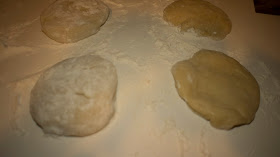Bifes a Minha Maneira
Serves two
2 8-ounce strip or rib-eye steaks
2 or more large slices of sweet red pepper pickled
6 cloves of garlic, halved
2 Bay leaves
Red, crushed pepper
1 cup white wine
Olive oil
Red Wine Vinegar
2 eggs
Let sit a minute or two to tenderize the meat. Rub vinegar on steak and wait another minute.
Pour olive oil into a skillet and when hot place both steaks in pan.
Add garlic cloves, being careful not to burn them!
add the red crushed pepper and a bay leaf on each steak. Take a teaspoon and rub the pepper right onto the steak itself.
Meanwhile, fry eggs in a separate skillet over easy and set aside.
To steaks, add more olive oil as needed to cook the garlic. Add wine and deglaze the pan once steaks are almost done.
Stir sauce around in pan. Reduce the sauce to the desired consistency, adding more wine if needed.
The sauce should be bubbling. Serve steak topped with sauce, peppers and fried egg.
Please let us know how this comes out for you!


















































